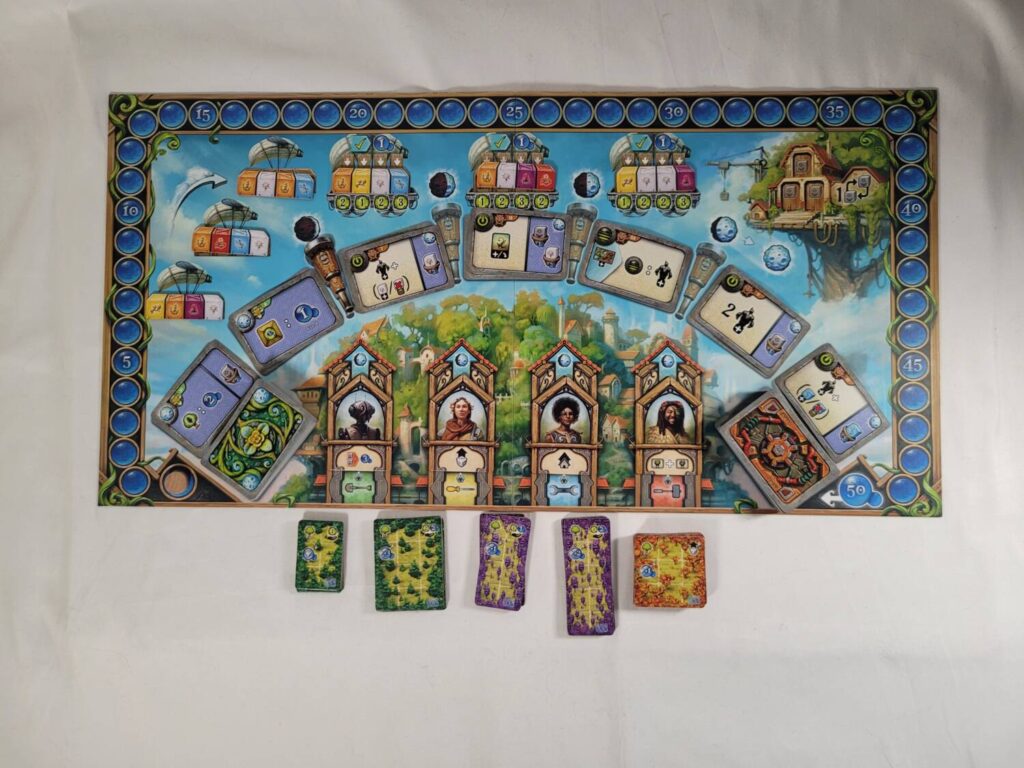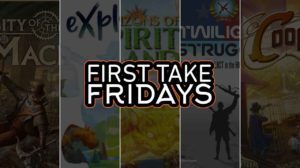Disclosure: Meeple Mountain received a free copy of this product in exchange for an honest, unbiased review. This review is not intended to be an endorsement.
From the rulebook: “It was our darkest hour. All the warnings, all the screams of the desperates. Nobody wanted to hear them. Until it was almost too late. Until only burned soil was left. We couldn’t save ourselves, but the trees could. As if they knew that their time for action had come. They showed us what mattered. We understood them and connected with them. Now we know what to do and we support them as good (sic) as possible with the little technology that [is] left. But also with a new, more natural technology, the Arbors showed us. We need green energy and oxygen, to turn burned soil into live-giving green. You can find it everywhere in our new and promising world of Overgrown…”
In Planta Nubo, the players tend the sky gardens atop the canopies of the Arbors. Flower beds produce flowers which are harvested, carried away, and turned into the green energy that keeps civilization running. The soil left behind is fertile ground for planting new forestation which, in turn, creates the life-sustaining oxygen the planet so desperately needs. Each element of the system feeds into the next in a self-perpetuating cycle.
Zoomed Out – A Brief Overview of the Layout and Some General Concepts
At its heart, Planta Nubo is an engine-building game governed by a worker-placement style action selection system.
During setup, the main board is placed between the players and loaded up with a number of Freight Container tiles, Crafting tiles, and Extension cards. A display of Action tiles is created close to this. These Action tiles are bordered by stacks of Flowerbed tiles in six different colors: blue, purple, white, red, yellow, and orange.
Each player is provided with a Platform board (a.k.a. Player board), a Tool Shack board, some wooden pieces, and a die in their chosen color, as well as several Tool tiles. The Platform is seeded with a few starter flower cubes as well as two starter Extension cards of each type (Modules and Oxy Farms). These cards are placed around the edge of the Platform and connected to the Platform by some Plugin Markers. These markers are double-sided, featuring a green energy space on one side and a green energy space with an oxygen (a.k.a – victory point) symbol on the reverse. Plugin markers are turned to their non-oxygen icon side when they are initially placed. Some game effects may cause these to become turned over.

Each player turns their six-sided die to the single pip side and places it into its starting position. Over the course of the game, players will be performing actions which will cause their die to travel in a clockwise position around their Platform from one green energy space to the next. As Module cards are passed, they will accrue either Standby or Battery counters on them, depending on what type of Module card they are. At different points in the game, Module cards with Standby counters can be activated by discarding Standby counters from them in order to perform their actions. Modules with Battery counters fire off when the card’s criteria are met, and the power of the action is increased the more Battery counters there are. If the die passes over a green energy space with an oxygen symbol on it, the player also scores a victory point.
The other type of Extension cards, the Oxy Farms, provide end-of-game victory points for meeting specific conditions. Like Modules, these are slotted in using Plugin Markers. Unlike Modules, these do not acquire any sort of counter when they are passed.
The Tool Shack board serves as storage for your personal Freight Container tiles as well as a home to your Gardenbot and your Arbor Level tiles. Freight Containers are where you’ll be delivering flower cubes to over the course of the game. Each cube delivered translates into green energy movement. The Freight Containers on the Main board can accept cubes from anyone, but the ones on your Tool Shack are yours and yours alone. The Arbor Level tiles provide instantaneous benefits as well as ongoing income if you’re able to meet their criteria. The higher the level you’ve progressed to, the better the reward. I’ll touch on the Gardenbot momentarily.
Zoomed In – Putting it All Together
Planta Nubo is played over the course of four rounds. Each round is broken into several distinct phases.
In the first phase, the Tool phase, players take three turns each. On a player’s turn, they will place one of their Tools in between two Action tiles, or an Action tile and a stack of Flowerbed tiles. They then perform the actions on one of those tiles, with the option of performing the actions associated with both tiles (which we’ll get to momentarily). Action tiles, as their name suggests, provide actions. Flowerbed tiles are different colored polyomino tiles which players will be collecting and placing onto their Platforms. These come into play covered with one flower cube of the matching color for each space the Flowerbed tile is composed of.
No Action tile may be bordered with the same type of Tool tile. So, if a player has used their shovel to select an Action tile on their turn and you want to use the same Action tile on yours, you’d have to use a Tool tile other than the shovel. This decision of which Tool tile to use is an important one for two reasons. Firstly, clever players can take note of which tools their opponents have used and effectively block them from using specific actions. Secondly, each player is only going to be choosing actions with three of their four Tool tiles. The fourth Tool tile dictates which action they’ll be using during the second phase, called the Crafting phase.
There are many actions to choose from in the Tool phase. Some allow you to deliver flower cubes from your playing area to the Main board to earn green energy movement and/or victory points. Some allow you to add charges to your Gardenbot. These charges can be spent in various ways such as paying the cost for some Module actions, making it easier for you to make certain flower cube deliveries, or allowing you to use both tiles that your recently placed Tool tile is bordering.
There are other actions as well, but just know that the meat and potatoes of Planta Nubo is building an engine of Module cards to help you in your quest to cover as much of your board as possible. You’ll do so with Flowerbed tiles and delivering the flower cubes that come along with them to make space for high scoring Forest tiles later on.

In the Crafting phase, a player’s fourth tool is placed next to the Crafting tile matching their remaining Tool tile. These Crafting tiles will provide the players with one of twelve extra benefits. A few examples are the ability to remove a barricade (opening up extra space to build on your Platform), gaining extra Soil tokens to your supply (these are useful for filling in gaps on your Platform board and come into play with a flower cube of your choice on them when they’re added to your board), or gaining a free bot charge.
In the following phase, the Forest phase, each player may add one of the available Forest tiles to their Platform (assuming they can accommodate it) OR flip one of their already collected Forest tiles to its opposite side. Adding a Forest tile to your Platform will gain you some kind of immediate bonus and, potentially, some sort of income during the next phase. Flipping these Forest tiles will deprive you of that income, but will earn you extra victory points at the end of the game.
After the Forest phase comes the Income phase. You will gain income from anything that depicts the income symbol on it—typically victory points or green energy movement. You will also gain a victory point for each pip on your die.
End Game
At the end of the fourth round, players will earn end-of-game points from a number of sources—flipped over forests, Oxy farms, leftover resources, etc. These final points are added to any points players may have scored over the course of the game, and the person with the highest total wins.
Thoughts
Before I get too far into my thoughts, I’d like to address the elephant in the room.
While this article is one in a series celebrating all things Uwe Rosenberg, it would be a disservice to not mention that Planta Nubo is a co-design between Uwe as well as two other top-notch designers: Michael Keller and Andreas “ode” Odendahl (perhaps most well known for one of their other co-designs: La Granja). That doesn’t discount Uwe’s handiwork, though. In fact, according to ode’s Designer’s Diary, it could be argued that, without Uwe Rosenberg, Planta Nubo never would have even been invented in the first place, as Planta Nubo began its life as a dice-driven version of the Rosenberg classic At the Gates of Loyang. I highly recommend giving it a read. It’s amazing to see where Planta Nubo is now versus how it started.
With that said, onwards to what I think.
Have you ever played a game that you liked so much that the experience is almost entirely ruined by one tiny little oversight—a misspelling, a rule book that directs you to the wrong page for a concept, an image that was printed upside down by mistake, etc.? That’s how I feel about Planta Nubo. I LOVE this game. It’s one of the best games I’ve played this year.
Yet, I wonder: whose bright idea was it to include only one single Player aid?
I get excited whenever I have the chance to bring this game out and share it with people that have never experienced it before. But, I feel almost personally ashamed when I go over all the complicated turn structures with all the intricate rules and regulations and then hand them the one and only Player aid in the entire box to share between them. There’s a look that passes between them and me. It’s a look that says “Where’s MY player aid?” And, my only response is a sad shaking of the head. “Buddy, there ain’t one. This is all we’ve got.”
Were it not for that one blemish, Planta Nubo would be a perfect game.

For starters, Planta Nubo looks incredible. Lukas Siegmon’s illustrations are bold, vibrant, and inviting. The rest of the components are just as worthy of praise. It’s just a beautiful, well-produced game. Once it’s laid out on the table, it’s hard to resist its allure. More than once, I’ve been playing it somewhere and someone wandered over to the table to ask which game it was.
From a pure gameplay perspective, it’s obvious that this game spent a lot of time in development. All the game’s various cogs just mesh together too perfectly for it not to have. To call the design polished would be underselling it. All the disparate elements come together in harmony. A begets B begets C begets D begets A begets B… you get it. Each piece is needed in order for some other piece to work, and the puzzle of trying to figure out how to get each of those pieces to work more efficiently is just lovely.
The game abounds with tough decision points. It’s a game that simultaneously rewards careful planning as much as it does the ability to react quickly to rapidly changing situations. For example, most rounds start with you assessing the available Crafting tiles and setting aside the tool that you know you’re going to need in order to use the one that speaks to you the most. But, you’ve got to be prepared for this to change. As other players place their Tools, their selection of which Tools to place as well as where to place them will begin to constrict the options that are available to you when it comes around to your turn. Whereas you may have wanted to use your shovel during the Crafting phase, you may find yourself wanting to take a useful action, but other tools have been placed around it such as to dictate the only viable tool that you can use is your shovel. So, do you choose something else so that you can hang onto your shovel? Or do you pivot and change your plans midstream? Is there a way to use these tool placement strictures to force your opponents to have to make similar tough decisions?
Another interesting aspect is the need to find balance between Module cards and Oxy Farm cards. Every Oxy Farm card taken is a nod to the end game. But every Oxy Farm card taken is one less Module card gained—one less immediately useful thing you could do and one extra step that your die must take on the green energy track without producing any immediate benefit. Finding that balance is critical to doing well, and it isn’t easy.
This game: is a lot to learn, so make sure you’re well-rested before you dive in; can run long, so make sure you’ve set aside the time to play it; will test your ability to plan, adapt, and overcome, so strap on your strategy hat and put on your tactic goggles because you’re going to need them.
Planta Nubo asks a lot of you, but it’s worth the investment.











